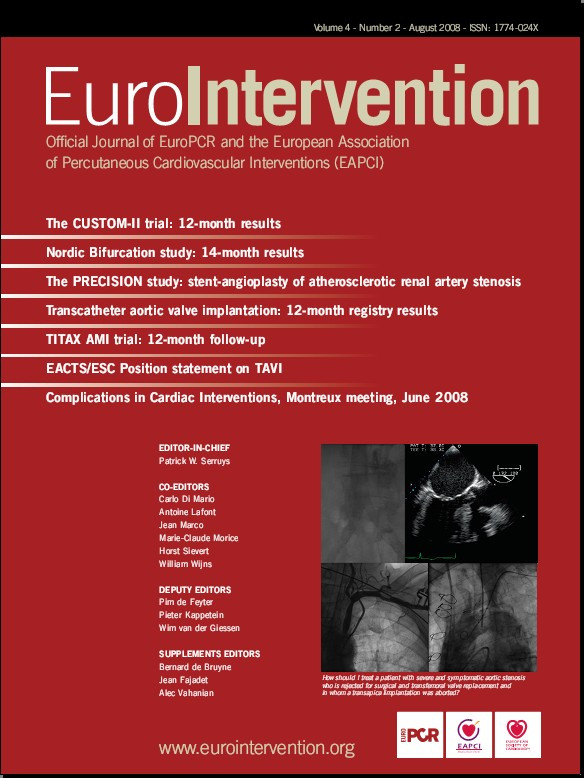People are always saying that there are too many congresses in every branch of medicine and perhaps this is true, all the more reason that the European Association of Percutaneous Cardiovascular Interventions (EAPCI), which is not in favour of excess, plays an active role in ensuring what does exist is of the greatest value to those attending. The EAPCI supports and endorses the scientific sessions of the various national interventional cardiology groups in different European countries, as well as specific meetings dedicated to fellows-in-training in interventional cardiology (a list is available on our website at www.escardio.org/
communities/EAPCI).
However, we play a different role in the annual subspecialty course on interventional cardiology which is EuroPCR, our official meeting as well at the annual congress of our mother society, the European Society of Cardiology (ESC). Here, our involvement is active and deep, shaping the essence of the meeting schedule itself. Having just returned from EuroPCR in Barcelona, we now turn our preparations to the ESC congress in Munich. Delegates from the EAPCI, who also sit on the scientific organising committee of the ESC congress directed by Fausto Pinto (chairman for the next 2 years), will soon begin the first steps towards 2009 congress preparation. Discussing how to insure that the ESC annual congress remains at the most exacting level of quality in its scientific medical and educational programme – a fact, witnessed by the increasing number of participants worldwide in this annual event. Obviously education and communication in our field is a continuous process and the EAPCI is playing an increasingly visible role.
We have highlighted below a number of sessions of particular interest at this year’s ESC Munich annual meeting – with its emphasis on coronary imaging. Visit www.escardio.org/CONGRESSES/ESC2008 for more information.
Hot Line II: recently completed clinical trials in interventional cardiology
Monday 1 September, 11:00 - 12:30 – Room Munich, Zone A4
The Hot line Session II chaired by Prof. P. Widimsky and Dr. W. Wijns will be of particular interest for interventional cardiologists. The one year results of the SYNTAX (Synergy between Percutaneous Coronary Intervention and Cardiac Surgery) trial will be presented by the principal investigators of this 3,075 patient trial, the interventional cardiologist Prof. P.W. Serruys and the cardiac surgeon Prof. F.W. Mohr. Comparing CABG and PCI using drug eluting stents in patients with three-vessel and left main stem disease, the results will, hopefully, put years of debate between surgeons and interventionalists on a new footing, providing much awaited data on what is the best revascularisation treatment for patients with left main stem and multivessel disease.
In the same session other clinical trials will be presented:
– CARDIa, a randomised trial of bypass surgery versus angioplasty in diabetic patients, a 600 patient trial from the UK and Ireland, whose results complement SYNTAX, though on a smaller scale.
– LEADERS, the one year results of a study which is a randomised comparison of a biolimus-A9 eluting stent with a sirolimus-eluting stent in all-comers, without the strict inclusion criteria which have limited the applicability of the results of most DES studies to current clinical practice.
For those of you interested in hearing more information from the SYNTAX trial, you will have the opportunity to “Meet the Trialists” and interact directly with the presenters of this trial.
ESC Andreas Gruentzig Lecture on Interventional Cardiology
Sunday 31 August, 14:00-15:30 – Rome - Zone C
This year’s ESC Gruentzig lecture will be chaired by Prof. M. Tendera and Prof. M. Komajda. It will feature a presentation by Dr. R. Virmani on how preclinical biocompatibility studies in various animal models help predict human responses to intravascular devices.
Other sessions of interest include:
Cardiac Anatomy for Interventional Cardiologists
Sunday 31 August, 10:00 - 12:30 – Cardiac Anatomy, Zone B4
Association Track (Focus Session) – The best of EuroPCR08
Sunday 31 August, 08:30-10:00 – Room London, Zone B4
And new this year, an interactive Session on
“Everything you always wanted to know about myocardial infarction and were afraid to ask”
Tuesday 2 September, 10:15 - 10:45 – Room Algiers, Zone C
EAPCI General Assembly
Monday 1 September, 15:30 - 16:30 – Room 11, Level 1, Zone C
This will be the occasion for us to report on recent activities and new initiatives with special focus on interventional training, as well as the perfect opportunity for you to show your support and positive suggestions. The modalities for next year’s election will also be announced.
To find out more about EAPCI, to learn about the EAPCI Membership Programme or gather information on next year’s interventional fellowships, as well as on other sessions of interest during the Munich meeting, please come and meet us at one of our stands, located in Zone B2 or at the ESC Membership Stand, Zone C or all year round at www.escardio.org/communities/EAPCI.

